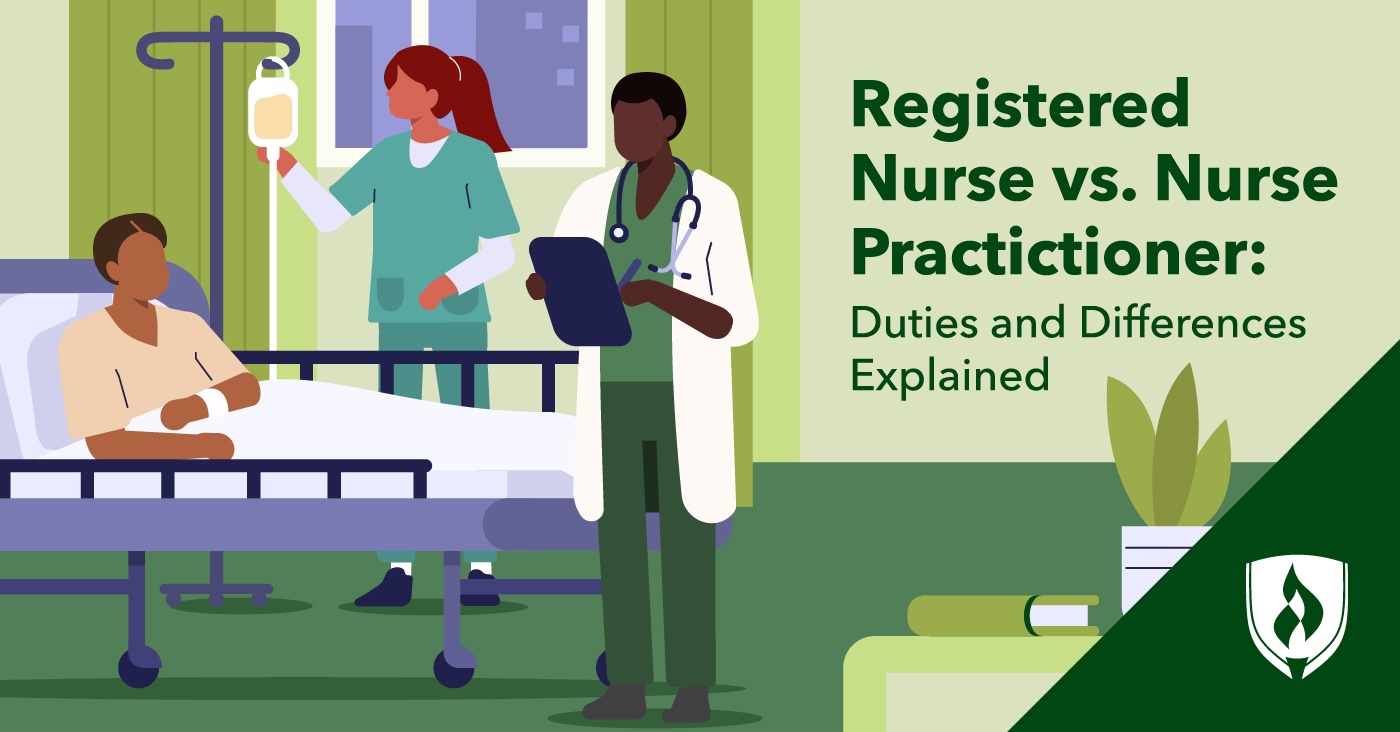Registered Nurse vs. Nurse Practitioner: Duties and Differences Explained
By Carrie Mesrobian on 04/25/2022
If you find yourself in need of nursing care, you probably aren’t going to be aware of the credentials of the person caring for you—you’re just focused on doing what needs to be done to feel better. But if you’re considering a career in nursing, it’s important to know the different levels of education involved in the profession, as there are key differences in training and responsibilities.

The healthcare field has no shortage of seemingly similar-sounding job titles, and that’s certainly true of the registered nurse (RN) and the nurse practitioner (NP) roles. While both have “nurse” in the name, there are some critical distinctions you should be aware of as you explore potential career options.
To help you get these roles sorted out, we’ve asked healthcare professionals to weigh in and provide an overview of some of the key differences. Let’s start by taking a look at each role individually.
What is a registered nurse (RN)?
A registered nurse (RN) is a person who has earned either an Associate’s or Bachelor’s degree in nursing, passed the NCLEX-RN® licensure exam and has met all other requirements for obtaining a state license to practice as an RN. You can find RNs working in a wide variety of healthcare settings where they provide direct patient care.
“RNs have a scope of practice that includes selecting and providing nursing care and interventions along with carrying out orders from NPs, physician assistants and MDs/DOs,” Dr. Jenna Liphart Rhoads, a nurse and advisor at Nurse Together.
What is a nurse practitioner (NP)?
A nurse practitioner is an advanced practice registered nurse with an expanded scope of responsibilities. Prospective nurse practitioners must first obtain RN licensure and then complete a graduate-level Nurse Practitioner program—either a Doctor of Nursing Practice or Master of Science in Nursing. Like RNs, prospective nurse practitioners must also pass a certification exam as well as meet all other state-determined eligibility requirements needed to practice.
What this additional education and training amount to in a work setting is a larger scope of practice and more autonomy over care decisions.
“A nurse practitioner goes through additional schooling and gains the skills needed to take on a more autonomous role when treating patients,” says Kenny Kadar, president of Coast Medical Service.
While there are certainly differences in training, regulation and overall authority between the roles, an outside observer might not easily detect much difference between an NP and a medical doctor when interacting with patients.
“NPs can do much of the same work that doctors do in a variety of settings that includes rounding on in-patient units, seeing patients in clinics independently, performing procedures, writing orders and prescribing medications,” says Liphart Rhoads.
It should be noted that across the United States, there are different regulations regarding the scope of practice for nurse practitioners. Some states do not allow NPs to prescribe certain medications while others require them to work under a supervising physician—and the details of how that supervision takes form can vary by state. For more details on what each state allows, the American Association of Nurse Practitioners® provides a state-by-state overview of licensure and practice laws for nurse practitioners.
What are the differences between nurse practitioner and registered nursing roles?
We’ve established that RNs and NPs are important, distinct roles. But how do they compare from a healthcare professional’s point of view? Michelle Bliss, an oncology/hematology nurse practitioner, says the most apparent differences are tied to NPs increased scope of practice—and the level of responsibility that comes with it.
To illustrate, Bliss offers the example of working with patient lab results.
“RNs are expected to review labs but are not responsible for interpreting those labs, while NPs write the orders for the labs, interpret them and diagnose,” Bliss explains.
Depending on the setting, there may be differences in the total number of patients an NP or RN interacts with in a given day—often RNs will be assigned to a smaller subset of patients in a specific unit while an NP will need to check in with all.
Scope of practice differences can often mean different work expectations and hours, as well. As an RN, Bliss says she typically worked her shift and went home.
“It was rare to be contacted about work or a patient once you left for the day,” Bliss recalls. “As an NP, I sometimes get paged after hours, or have physicians call me at home, chart at home and often work late.”
The trade-off to having additional responsibility and educational requirements as an NP comes through when comparing earning potential.
How are nurse practitioner and registered nursing roles similar?
Clearly both NPs and RNs play a direct, hands-on role in patient care—but how else are they similar?
For one, both RNs and NPs can pursue specialization to focus their work on a specific type of care. For example, RNs may specialize in intensive care, pediatrics or as PACU nurses in post-anesthesia care—and that’s just to name a few. Nurse practitioners also have the choice to pursue specialized focus areas like adult-gerontology, psychiatric-mental health, pediatrics and more. One distinction regarding specializations you should be aware of is that NPs choose their specialty focus prior to or during graduate school, while RNs have the flexibility to change concentrations after obtaining licensure.
Work setting is also an area of significant overlap. Both RNs and NPs work in similar healthcare spaces, such as family clinics, hospitals and specialty settings like outpatient surgical centers.
For Liphart Rhoads, the similarities in the roles are rooted in nursing education.
“The similarities come down to initial education and philosophical views of patient, nurse, health and environment,” says Liphart Rhoads. “RNs and NPs tend to have the same holistic view of patients and health, which directs the compassionate care that they provide.”
Bliss also says that her nursing foundation continues to inform her work as a nurse practitioner.
“Nurses are taught to treat the entire person, to attend to physical, spiritual and emotional needs of the patients,” she explains. “My RN experience taught me how to talk to patients and families and made me more empathetic. Patients tend to entrust more personal things to their nurse, like financial and family concerns. This has helped me become more aware of things that can impact their care.”
Can registered nurses become nurse practitioners?
The good news for anyone torn between these roles is that making the transition from RN to NP is relatively straightforward. Specific eligibility requirements will vary from program to program, but most NP programs will at a minimum require candidates to have completed a Bachelor of Science in Nursing program and obtain RN licensure in order to enroll.
While it’s a straightforward path to educational advancement for most registered nurses, the effort and investment required of nurse practitioner students should not be taken lightly. Becoming a nurse practitioner is a significant step up in the decision-making and care hierarchy, and with that comes extensive training and education.
“The majority of nurse practitioner programs take three to five years, depending on the school,” says Bliss. “This experience typically includes graduate-level classes, clinical hours and a capstone project.”
A bright career outlook, no matter the role
Both registered nurses and nurse practitioners are going to play a critical role in meeting the substantial healthcare needs of an aging baby boomer generation. The BLS projects employment of nurse practitioners to grow by 52 percent from 2020 to 2030 and projects employment of registered nurses to grow by 9 percent during that same period.
No matter the nursing role you ultimately choose to pursue, you’ll have opportunities to make a real difference in the lives of patients under your care. If you’re ready to learn more about the steps you’ll need to take toward starting one of the compassionate, caring careers, check out our article “How to Become a Registered Nurse: A Simple Step-by-Step Guide.”
1Bureau of Labor Statistics, U.S. Department of Labor, Occupational Outlook Handbook, [accessed March 2022] https://www.bls.gov/ooh/healthcare/registered-nurses.htm and https://www.bls.gov/ooh/healthcare/nurse-anesthetists-nurse-midwives-and-nurse-practitioners.htm Information represents national, averaged data for the occupations listed and includes workers at all levels of education and experience. Employment conditions in your area may vary.
NCLEX-RN is a registered trademark of the National Council of State Boards of Nursing, Inc.
American Association of Nurse Practitioners is a registered trademark of American Association of Nurse Practitioners, Inc.




